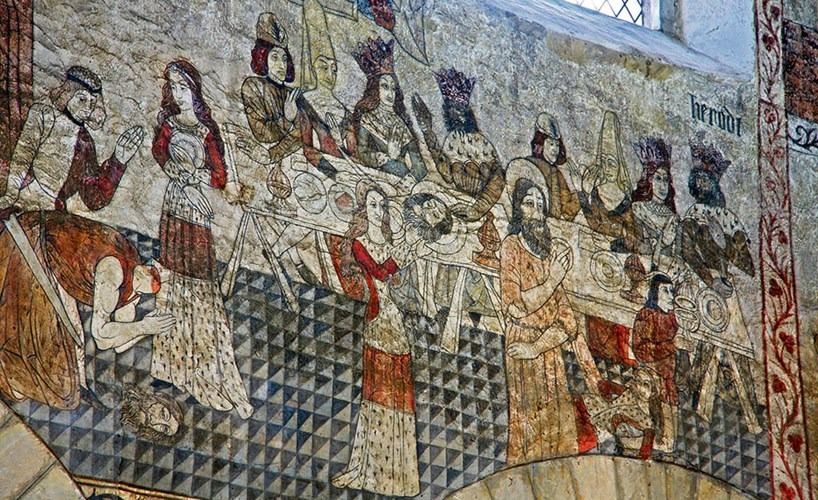
by Moe | Jul 10, 2018 | Mystical Christianity
In the Greek New Testament, the Apostle Paul spoke of the married brothers of the Lord and the married Kephas (Saint Peter/Simon & His Desciples).

Paul speaks of having not the “same power” as the Lord and Simon when he proclaims, “Have we not power to lead about a sister, a wife, as well as other apostles, and as the brethren of the Lord, and Cephas?” (Greek: μὴ οὐκ ἔχομεν ἐξουσίαν ἀδελφὴν γυναῖκα περιάγειν, ὡς καὶ οἱ λοιποὶ ἀπόστολοι καὶ οἱ ἀδελφοὶ τοῦ Κυρίου καὶ Κηφᾶς – 1 Corinthians 9:5)
When the Apostle Paul speaks the Greek word εξουσιαν, it implies power and a right, that he and all other apostles, had a legal right to marry.
Paul speaking like a Gnostic, or who we can call a perfect Christian, says, “εσθιει, και πινει, και γαμει – εικονας εχει τους Αποστολους, He eats, and drinks, and marries – having the apostles for his example. Vid. Clem. Alex. Strom., lib. vii., c. 12.
The only married Apostles that we have direct evidence on good authority are Peter and Philip (Papias in Eus. H.E. iii. 39):
For example, it is certain Simon, Saint Peter AKA Kephas (Cephas) – the first Pope had a wife; see Matthew 8:14:
Then Jesus said to the centurion, “Go! As you have believed, so will it be done for you.” And his servant was healed at that very hour. When Jesus arrived at Peter’s house, He saw Peter’s mother-in-law sick in bed with a fever. He touched her hand, and the fever left her, and she got up and began to serve them.”
It also appears that the Lord’s brethren, James and Jude were married.
Paul speaks of the married brothers of Jesus and the oldest gospel, Mark, mentions James, Joses, Judas and Simon as his brothers and besides sisters (Mark vi. 3).
This was the time when Paul was evangelizing to the many Gnostic schools in Corinth which I know to be on Crete, who some of the disciples there declared, “I follow Paul”; another, “I follow Apollos”; another, “I follow Kephas”; still another, “I follow Christ.” (1 Corinthians 1:12)
The passages above indicate a select inner circle of men who were the “brethren of the Lord,” and the flesh-and-blood kinsmen of the man Jesus and some of these brethren continued in different schools or ministries.
The facts are that if we are to interpret these meanings truthfully, we will concur that “the Lord’s brethren” – The Apostles were either married men or had the legal right to marry.
And Saint Peter, the Prince (Son of a Monarch) of the Apostles First Pope was also married, yet was an apostle of Christ.
This is Christian Truth.
Moe is the founder of GnosticWarrior.com. He is a father, husband, author, martial arts black belt, and an expert in Gnosticism, the occult, and esotericism.
by Moe | Jul 7, 2018 | Mystical Christianity
On the ancient Holy Island of Crete sits the Temple of Knossos (AKA Gnosis) at the bottom of a hill that was once called “Kephala” (Kephala tou Tselevi). It sits on the western bank of the Krateros river to the south of the modern city of Heraklion, also known as Iraklio.
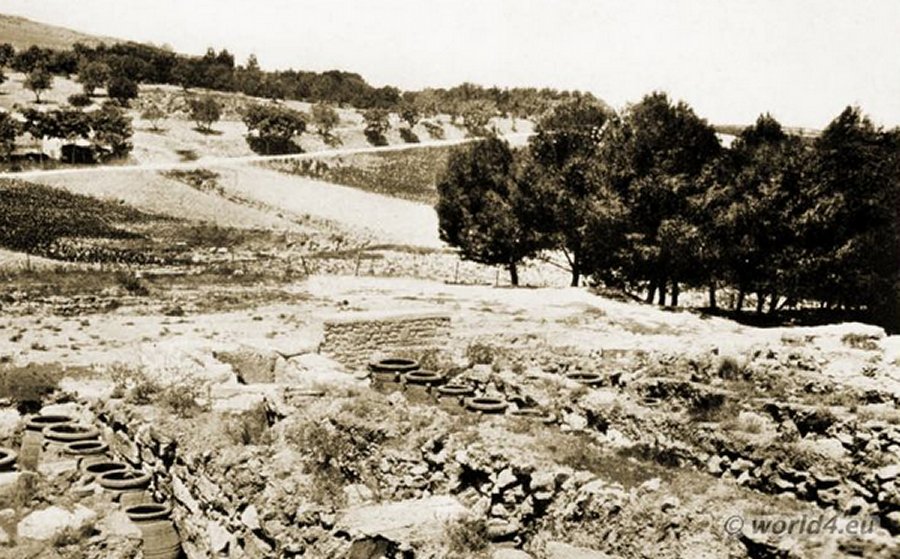
It is said that this location was chosen by ancient settlers for the site of the Palace of Knossos; the footprint of the Neolithic settlement at Kephala Hill was actually larger than the Bronze Age Palace of Knossos. This was the true first “Ancient City of Gnosis.”
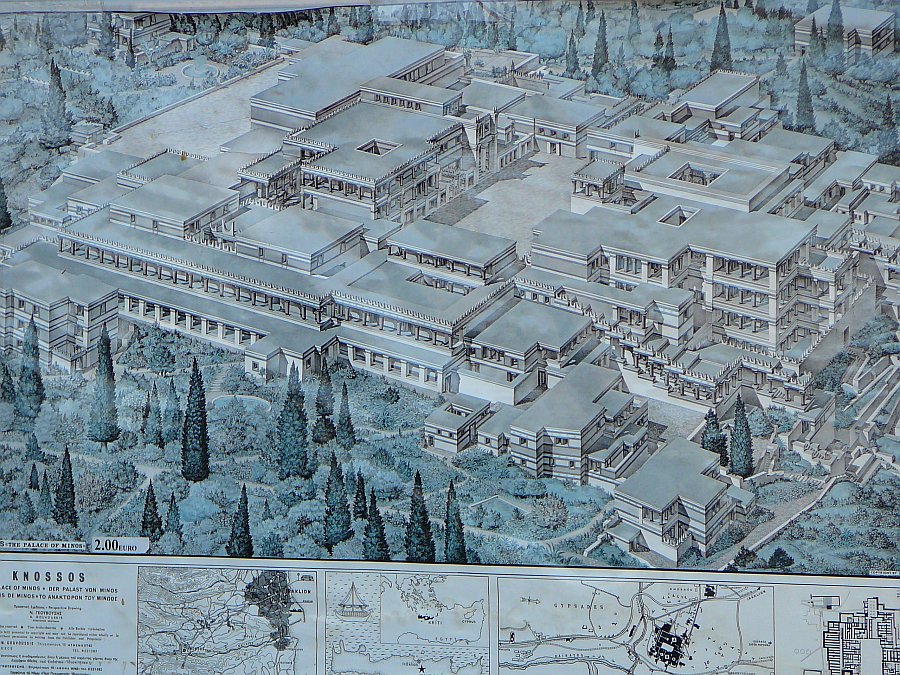
We can find evidence of these facts encoded into the royal mythology of Ancient Crete with the story of King Kephalos (Cephalus) of Crete and Thorikos who was one of the twelve towns of the Synoekismos of Theseus. Kephalos is said to have come to Athens, married the princess Prokris, accidentally killed her, and was exiled from Athens (Mussies 1986: 44). The king is said to rule over the “villages of Kephalos,” from the steep and lofty headland of Kephalos.
Coincidentally, the discovery of what we know today as the “Kephala Tholos Tomb”, north of the palace of Knossos, proves that this mythology is based on true history as always was the case as it is in the Scripture which the two go hand and hand wherever the priesthood had travelled.
This royal tomb was found some 300 meters to the east-northeast from the Kephala hill. It came to light during what are described as “cleaning operations of the olive grove” by a small bulldozer, which resulted in the what they had called the removal of the “key of the tholos.”
Due to the circumstances of the discovery and the urgent need for protection of the site, the investigation started from the chamber, and the excavation team had to enter from the hole of the key. Escavations were eventually carried out in 1998 by the Greek Ministry of Culture under the direction of Theodoros Eliopoulos.
More evidence of the Cretan people known as the ‘Kepha’ is found mentioned in the Ancient Egyptian texts in conjunction with Crete which was called Keftiu and the same peoples who appear in the history and monuments of Egypt under the various names with one being “Kepha.”
The Ancient Egyptian, Ka is usually translated as ‘double’, because it represents a person’s double or what we can call their higher self. It also means spirit or spirit of the blood. Hence, a vessel in our bodies that carries our Ka (Spirit), is called a blood canal (Ka’nal).
The Ka Priests of Kepha – Holy Protectors of the Lord
In Ancient Egypt, the divine ka’s (Divine Angels and Good Demons) had served as guardians of Osiris who was often called the Ka of the Pyramids. In Ancient Greece, the divine Ka’s served as guardians of Zeus, the soul of this world.
These same said Ka’s – AKA guardians of Zeus and Osiris we find in Crete under a plethora of pseudo-names such as the Telchnines (Telknines, Telkhis, Telegonus, or Greek, Τελχῖνες) and Curetes who are placed has the Royal Guardiasn of the God Zeus. Strabo had written, that these are the names of the various groups of daimones or demons known as the Curetes (Kuretes), Corybantes, Dactyls, Cabiri, and Telchines which are names that are often used interchangeably with one another.
As I explained in my article, Simon (Saint Peter): Kepha of the Church, the word Kepha is derived from the Greek words “kepha, kephas and or kephalé,” which mean, “the head,” but also denote esoterically in religion as, “Ruler, Lord or a Cornerstone (Masonic), uniting two walls.” It is my belief that the original true story of Simon can be traced back to the ancient priesthood of the Holy Island of Crete and the City of Knossos (Gnosis).
Let me add that Simon was a fisherman and the great symbol of the Christians is a fish. The kephale (cephus, sefus) is a genus of the Cod-fishes, Cadidae, in which the head is remarkably large, depressed, and broad. Coincidentally, Crete was also once called by the Europeans – ‘Candia.’
Modern Evidence of the Villages of Kephalos
To this very day, you will find evidence of the Kepha like on Crete in Chania at a place called Kefali (Kephali). It is a small village with many old important Church sites with ancient frescoes such as Jesus and the washing of feet, fresco in the Byzantine church of Agios Athanasios or the Frescoes with Christ dead in Church of Metamorphosis tou Sotiros.
Kefali is located on the eastern side of Mount Elias, 60 km south west of Chania Town at a high altitude of 460 meters above the sea. The coastal road near Kefali to said to be one of Crete’s most beautiful and the mountainous village is surrounded by a beautiful verdant landscape and one of the nine villages, and close to the villages of Kissamos- Kaloudiana- Topolia- Elos- Kefali.
You will also find on Crete, Koukou Kefali, in English – Cuckoos Head (Rooster’s Head). It is located to the South-East of the village of Ano Zakro. There are “secret ancient ruins” here that were excavated as part of Arthur Evan’s so-called Minoan excavations and is called the Minoan villa “Tou Koukou to Kephali.”
Could these real life villages actually be scientific evidence of what is considered the “Villages of Kephalos,” from the steep and lofty headland of Kephalos?
This is an Apocalyptic possibility given the fact that there have been massive excavations done here and apparent secret political powers jockeying for control of these ancient holy sites. For example, what is titled, The Kastro Kallithea Archaeological Project: the 2016 study season – Schliemann at Knossos, this battle for the hill called Kephala tou Tselevi is detailed. Something tells me there is much more to this Biblical story…
The Canadian Institute in Greece reports:
The hill called Kephala tou Tselevi on the western bank of the Krateros river to the south of the city of Candia (modern Herakleio) on the island of Crete has come to be known world-wide as Knossos. Here at the beginning of the 20th century Arthur Evans began the excavations of a massive structure and portions of the surrounding settlement that we know today as the Palace of Minos.
Evans was not the first to excavate here,
however. Minos Kalokairinos (1843-1907), an olive merchant and antiquities collector from Candia, initiated the first test trenches on the hill for three weeks in December, 1878. He uncovered a portion of the West Magazines with their storage jars (pithoi) in situ and reached as far as the Throne Room. Given the political sensitivities of the time, as Crete was still under Ottoman rule, the Christian General Administrator of Crete, Fotiades Pashas, decided in 1879 that the excavations should stop. In 1880 he also refused the request of the French School in Athens to continue the excavations for the same reasons. Heinrich Schliemann of Troy and Mycenae fame entered the picture in 1886 seeking to dig at Knossos as well.
Evans did not arrive on the scene until 1894.”
The conclude, “What happened to deny Schliemann access to Knossos?”
One last note in regards to the place called Koukou Kefal Cuckoos Head (Rooster’s Head), as I mentioned in my article, Why Saint Peter is called Satan by Jesus, there is a peculiar reference to the rooster (Cock or Cuckoo) in Simon’s denial which takes us to Peter at Caesarea where he is preparing for a discussion with Simon Magus where there is a symbolic reference to Gnosis with the “rising at the first cock-crowing.”
Also, in the “Palace of Caiaphas” Peter renounces his Master three times, and as the cock crows thrice at his third denial. The name of Caiaphas is very close to Cephas or Kephas and most likely a reference to the same mythological Villages of Kephalos and the real towns and places called Kefal which can be witnessed by anyone on Crete
Double-Headed Defacto Rulers of Jerusalem and Successors to both Peter and Caesar
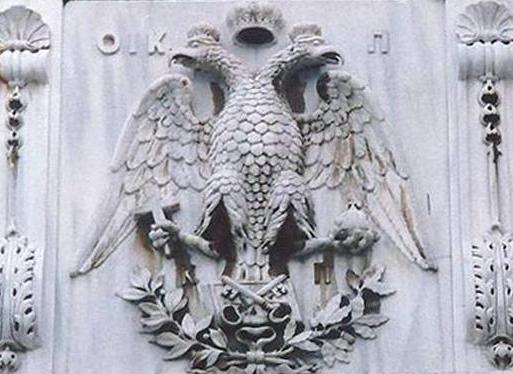
The use of Kephali is interesting given that Kephalee in Greek means Head and is said to be derived from the Phoenician /Hebrew, Kephal. A word who some say signifies, double.
An interesting note is that in the etymology of the compound word “Kephalos” we can find the words ke/ka, pha/pho and los or lus. If we are to dissect the meanings individually we will find that ke/ka is a word for ‘soul’, pha or pho is light or shining and los or lus which means little and can also mean esoterically;
‘Son’ as in “Little Son ie: Son of the Father ie: God” – “Sons of God.”
This is why in the Scripture, the Head Kephas can be found in relation to the “Son and Sons of God ie: Saints” who we know also hold the “Key to the Christian Mysteries ie: True Christian History/Gnosis.”
Interestingly enough, it has been said that the so-called Jewish origin of the symbol of the keys found in Revelation i. 18, iii. 7-9, (in Preuschen’s Zeitschrift ffir die neutest. Wissenschaft, iv. pp. 190192) that Kepha was the name given to a chamber in the temple where the keys were carefully preserved.
It makes perfect sense to call the land that the great city of Knossos, AKA Gnosis was built at the bottom of Kephala Hill upon by the name “head ruler” as being symbolically considered “as the ruler and the cornerstone of the world.” After all, as I have said numerous times, the island of Crete was considered for thousands of years as the holiest land in all the world and it was also known as the Center of the World and Soul of the World.
Control Crete, you hold the Royal Sceptre to the Soul of the World thus becoming the Double-Headed defacto rulers of Jerusalem and Rome as the legal successors to both Peter and Caesar.
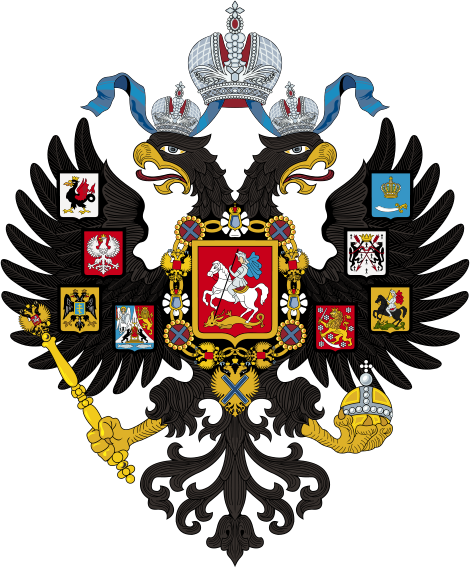
The Heavenly keys are held by the Sons of God, who holds the keys of Hades, by which the binding of demons and the gates of the lower world could be closed or opened. The Holy Protectors of Solomon’s Temple ie: Earth.
It should be no coincidence that Simon, AKA Kepha, AKA Saint Peter is the “Cornerstone of the Church” and he holds the Gnostic keys to the mysteries in his Right hand for it is said by the Lord;
“I will give you the keys of the kingdom of heaven; and whatever you bind on earth shall have been bound in heaven, and whatever you loose on earth shall have been loosed in heaven.”
Moe is the founder of GnosticWarrior.com. He is a father, husband, author, martial arts black belt, and an expert in Gnosticism, the occult, and esotericism.
by Moe | Jul 6, 2018 | Mystical Christianity
In John 1:42, we read that Simon AKA Saint Peter is given a special “code name” by Jesus when he says, “Thou art Shemeun, (Simon,) the son of Jona: thou shalt be called Kepha.”
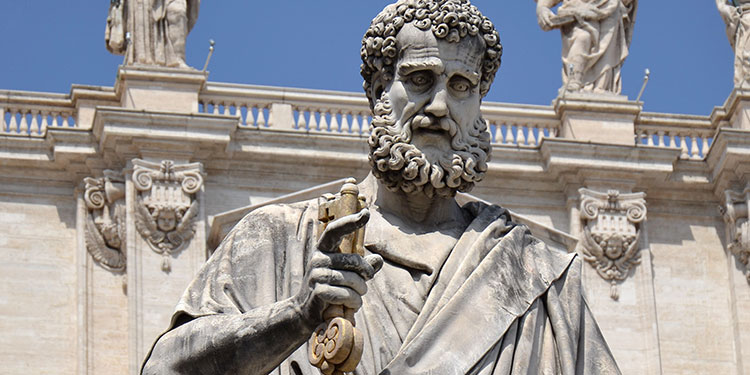
The above passage was said when Jesus first interviewed Saint Peter (Simon, Simeon or Symeon) to become his disciple (student) while teaching as part of John’s ministry (John 1:42). It was at this time that he gave him the surname “Kepha or Cepha.”
Later, Jesus tells Simon, “Thou art Kepha, and upon this kepha I will build my church.” (Matt, xvi, 18.)
A name and word that I believe is commonly misinterpreted by many theologians and authors to mean ‘rock’ and some could say is equivalent to “man of the rock.”
But I have found that this interpretation of the meaning is historically incorrect.
The reason I disagree is that you will not find the name Peter in the four Syriac Gospels, nor in the Epistles of Paul. The names that are found are “Shemeun (Simon) or Kepha, which answers to the English Cephas.
Also, if we are to research “true etymology” of the word Kepha, you will find that is is actually derived from the Greek words “kepha, kephas and or kephalé.”
Words that mean mainly – “the head,” but also denote esoterically in religion as, “Ruler, Lord or a Cornerstone (Masonic), uniting two walls.”
There are many words with kepha and or cepha which all denote head.
For example, we know that Simon, AKA Saint Peter, AKA Kepha was a fisherman and the great symbol of the Christians is a fish and interestingly we find the kephale (cephus, sefus) is a genus of the Cod-fishes, Cadidae, in which the head is remarkably large, depressed, and broad; the name also of a genus of Dipterous insects of the duck family.
A cephalla, se-fa’le-a, s. (kephale, Gr.) A genus of Dipterous insects, in which the fore part of the head is much prolonged, being without setae, and the palpi strongly dilated in the form of a spatula: Tribe, Musides.
This definition of the name Kephas for Simon makes perfect sense being that our Lord declared Peter as the “foundation for the church” and the leader of the 12 disciples and by the Roman Catholic Church as Prince of the Apostles and the first of its unbroken succession of popes.
It was for this reason that he was named the ‘head’ or should I say “Big head – as in wise ruler and or cornerstone – Kepha of the Church.”
Moe is the founder of GnosticWarrior.com. He is a father, husband, author, martial arts black belt, and an expert in Gnosticism, the occult, and esotericism.
by Moe | Jul 4, 2018 | Mystical Christianity, Satanism
Jesus turned to his Apostle Peter and said, “Get thee behind me, Satan: thou art an offense unto me: for thou savourest not the things that be of God, but those that be of men.”(Matthew 16:23)
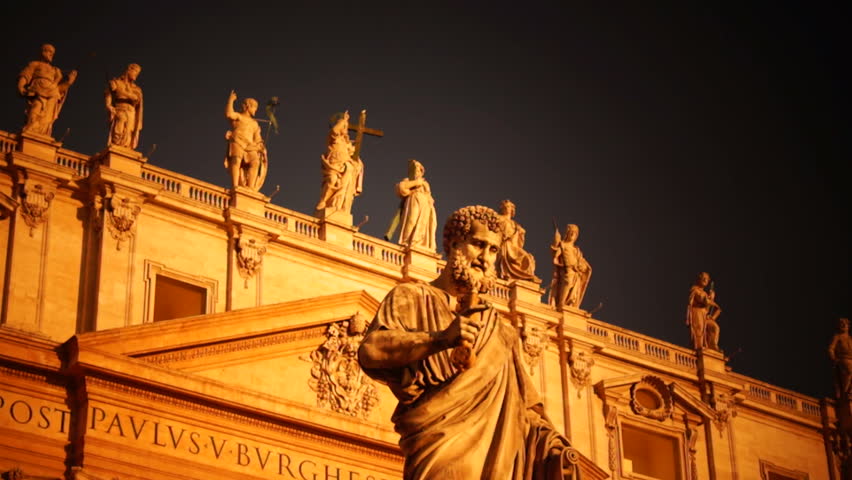
An interesting note that I would like to point out to you is that Jesus uses nearly the same exact words for Peter that he had used to the devil in his temptation (Matthew 4:10). ”
We know through Scripture and the testimony of the Church Fathers that Saint Peter’s original name was Simon and he was one of the Twelve Apostles of Jesus Christ, leaders of the early Christian Great Church, and Prince of the Apostles.
But what is often left out of these name appellation is that Peter was also known as “Satan.”
To many people, the thought of calling the “Rock of the Church” which Jesus built his ministry – Satan is an apostasy to the Christian faith but that is exactly what has occurred for approximately the last 2,000 years. These facts are explained allegorically all throughout the Scripture as I have presented in my articles such as Who is Satan?, and Satan: Thou art the anointed royal cherub with Gnosis that covereth.
Satan is presented to us as the God of this World, a deceiver, and a liar. These name appellations show us that he is in charge and he lies for God in order to carry out his special mission as Ezekiel 28:14 describes how the royal anointed cherub – Satan an assignment to “cover”. This Hebrew word means to cover as a protector guard.and or fenced in hedge of protection.
Mathew 16:23 shows us that Jesus called for Saint Peter to get behind him and he is Satan. Most people would say that to get behind Jesus is a good thing and I would agree but calling the same man Satan is a statement that is contradictory.
With that said, we must assume this is done on purpose as if it codifying a mystical message in allegory.
As I explained in my article, Who is Satan, the word Satan is derived from the ancient Greek Σατάν (Satán) and the Hebrew שָׂטָן (Sātān) which means “adversary, the accuser, to show enmity to, oppose, plot against,” from root s-t-n “one who opposes, or obstructs.”
Therefore, we can say that Peter became an “adversary” to Jesus’s teachings it was because he had followed “the path of men,” and for this reason, he was told by Jesus that he was now “Satan” and he would have to get behind him during his ministry.
What happens with Peter next is indicated by the next passage from Jesus where he says, “Whoever shall come after me, let him deny himself and take up the cross and follow me.”
It is clear that Peter and the Apostles had denied themselves and Mark mentions the two cock-crowings (chap. xiv. 72), thus increasing the guilt of Peter’s denial as Eusebius asserts on the authority of Clement of Alexandria.
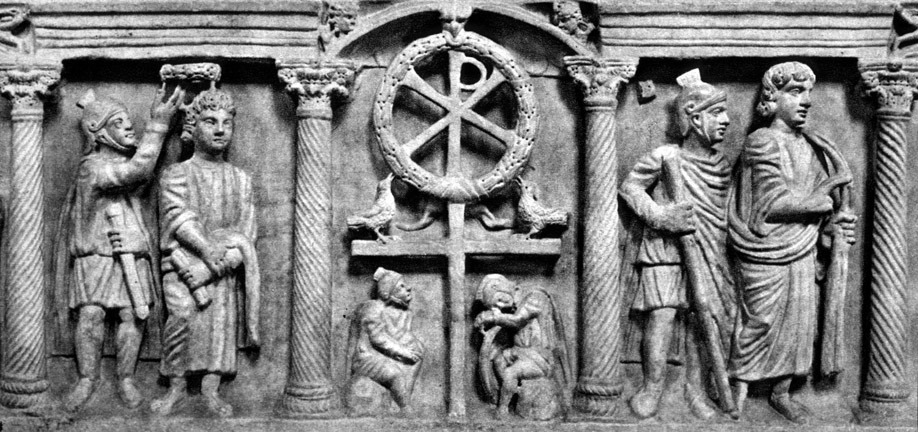
The reference to the rooster escapes most scholars’ radar but in my opinion, this is religiously symbolic of the Gnostic times. For the rooster was an ancient religious symbol which represented exoterically as the dividing line between night and day or more appropriately, for light and dark for the Rooster crows to signal the coming day/light of a New Age.
Symbolically, we can say esoterically that the Rooster is the awakening of the Holy Spirit or Holy Fire ie: consciousness and Gnosis of the eternal mysteries. The Rooster representing their savior as the speaker of the ancient Gnostic mysteries for who has louder pipes to crow?
This is why in ancient Gnosticism and with the Templars, we find the most important symbol being that of Abraxas who is normally depicted as a creature like a man with the body of a human being, the head of a rooster, one arm with a shield, and the other with a whip.
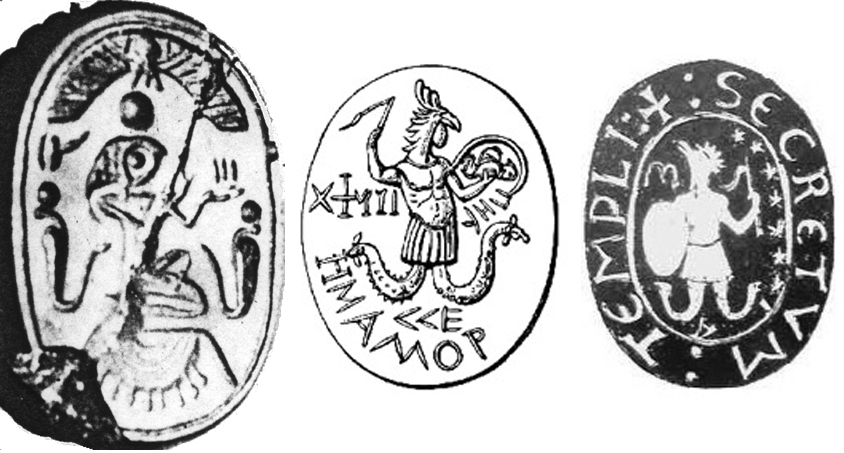
As I explained in my article, Abraxas, The early Fathers of the Catholic Church such as Irenaeus and Epiphanius had said that the world, as well as the 365 heavens, was created in honour of ‘Abraxas;’ and that Christ was sent not by the Maker of the world but by ‘Abraxas,’ and according to Jerome (c.347–September 30, 420) who is best known as the translator of the Bible from Greek and Hebrew into Latin, ‘
Abraxas’ meant for Basilides “the greatest God” (De vir. ill. 21), “the highest God” (Dial. adv. Lucif. 23), “the Almighty God” (Comm. in Amos iii. 9), and “the Lord the Creator” (Comm. in Nah. i. 11).
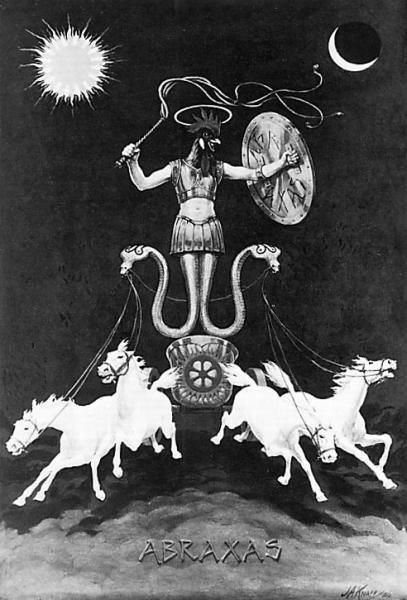
It was for this ancient Gnostic reason that the rooster was placed in the Scripture as one of the most important symbols of Gnosticism and also the Levite priesthood who I have explained in my articles, The Origins of the Kohanim Priesthood and the Levite Priesthood, are descended from the lineage of Aaron and Moses and whom spawned the Gnostic prophet – John the Baptist .
They were true Israelites from the Gnostic Ophite Order of Priests on the Dragon shaped island we know today as Dia. This island is also known by the name of Delos and more anciently as the island Kos or Cos which is named after Ceus (Zeus), the son of Titan, and has been known by various names such as Zia, Cia, Cea, Ceos, Coo, Coos, Cous, Merope, Lemnos, Letos, Staunchio and Patmos.
This is where we will find the famous so-called Rooster Cock Pillar that has since been moved to the “new Delos.” I will explain more about the Rooster when this “Levitical broken-cock” in chains has time…
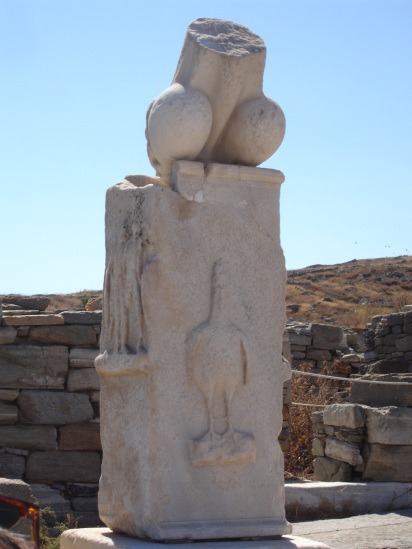
Back to the two cock-crowings of Peter’s AKA Simon’s AKA Satan’s denial which takes us to Peter at Caesarea where he is preparing for a discussion with the man we know as the First Gnostic – Simon Magus with the symbolic reference to Gnosis with the “rising at the first cock-crowing.”
“When the day dawned, which had been fixed for the discussion with Simon, Peter, rising at the first cock-crowing, aroused us also; for we were sleeping in the same apartment, thirteen of us all; of whom, next to Peter, Zaccheus was first, then Sophonius, &c. After these, I [Clement] and Nicodemus, then Niceta and Aquila, who had formerly been disciples of Simon, and were converted to Christ, under the teachings of Zaccheus. Of the women, there was no one present.”— Recognitions, book 2, chapter
In the “Palace of Caiaphas” Peter renounces his Master three times, and as the cock crows thrice at his third denial.
Let me add that there is also another reference to Peter and Satan was told in Luke, “Simon, Simon, behold, Satan demanded to have you, that he might sift you like wheat, but I have prayed for you that your faith may not fail; and when you have turned again [after the denials], strengthen your brethren” (Luke 22:31-32).
Moe is the founder of GnosticWarrior.com. He is a father, husband, author, martial arts black belt, and an expert in Gnosticism, the occult, and esotericism.
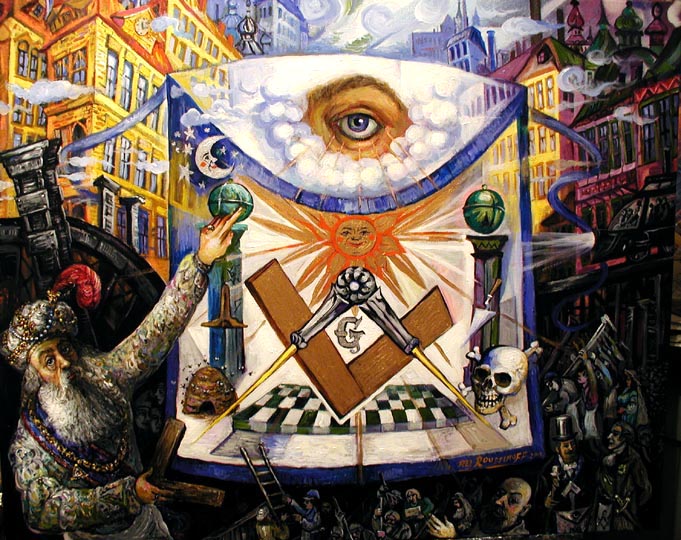
by Moe | Jul 2, 2018 | Freemasonry, Gnosis, Mystical Christianity
We find in Ezekiel 11:22 that the “King of Tyre” is called a “cherub” and his home is located at the residence of Eden and the Mountian of God for it is said, “the king of Tyre is scornfully compared with one of these, and is assigned a residence in Eden and the mountain of God.”

As I mentioned in my previous article, Satan: Thou art the anointed royal cherub with Gnosis that covereth, Satan was a type of angel called a ‘cherub,” and he became a guardian of the Holy of Holies when he was “anointed as the cherub that covereth.” and a specific reference is made to Satan having been to a place known as the “Holy Mountain of God” and “walked up and down in the midst of the stones of fire.”
We also find that the King of Tyre is associated with Satan as he is described as the cherub in Eden mentioned in Ezekiel 28:13-14. This king is said by religious scholars to be identified with specifically Ithobaal III (Latin Ithobalus, Hebrew Ethbaal) (reigned 591–573 BCE) who according to the list of kings of Tyre of Josephus was reigning contemporary with Ezekiel at the time of the first fall of Jerusalem.
As I explained before, most Jewish writers and Christian Fathers conceived the cherubim as angels with special knowledge, understanding, and full of wisdom ie: Gnosis. We know that God had appointed them as guardians and protectors (Templars) as representatives of the Divine Wisdom of the Lord in the higher heavens.
If we are to look to the history provided to us on the Kings of Tyre, we will discover that they were instrumental in helping build one of Freemasonry’s most prized symbolic structures – Solomon’s Temple. It is said in Samuel 5:11, “And Hiram king of Tyre sent messengers to David, and cedar trees, also carpenters and masons who built David a house.”
Are Simon (Saint Peter), Satan, the Cherubim, the King of Tyre, Freemasons and the Catholic Church all connected with one another?
It is interesting that we know that Satan was, in fact, a real person and that he is also biblically associated with the order of angels known as the Cherubim and the King of Tyre. Masons are also associated with the Royal Gnostic we know of as Satan ie; Simon Magus (Saint Peter). Even more interesting is that in Ezekiel 28:12-19, the Fall of the King of Tyre who is driven from the Garden of Eden almost perfectly matches the description of the original fall of the First Gnostic, Simon Magus, AKA Satan.
The Fall of this Royal Masonic family can be plainly seen in Genesis iii. 24 by the cherubim placed before the garden of Eden, when Jehovah God “had driven out the man, He made to dwell on the east of Eden the cherubim, and the flame of a sword turning every way, to guard the way of the tree of life ”
It is clear that the “cherubim” signify a special race of beings or royal family/bloodline with “spiritual knowledge and wisdom ie: True Gnosis” in which they are anointed as “royal guards” with flaming swords who were placed before the garden of Eden which could not be approached except by good of love and charity; for this reason they are also said “to guard the way of the tree” which we can freely say today in the Masonic States of America were the “Guardians of Ancient Gnosticism.”
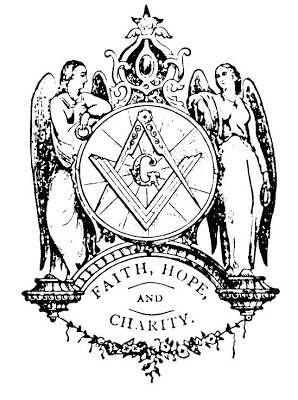
The Masonic Cherubim’s flaming swords “signifies the Word and truth combating against falsity and dispersing it, thus truth protecting” the way of “the tree of life” signifies True Gnosis from the Lord and the heavenly joy therefrom. From this, it is clear that the “two cherubim” represented guards of Mystical Christianity ie: Gnosis was not approached except by good of love and charity OR else!
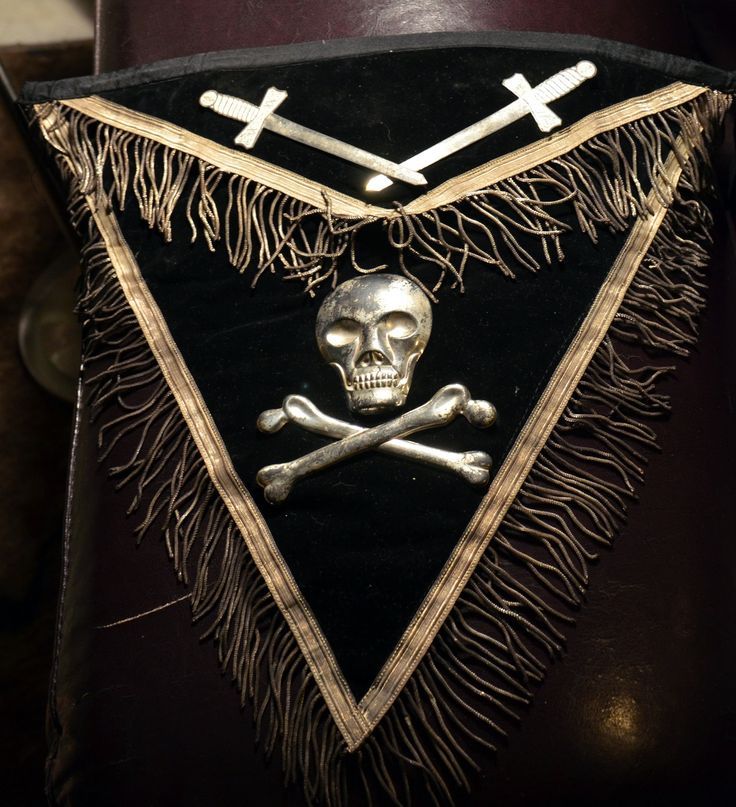
In my article, King Hiram: The Masonic Chief Architect from Crete, I explain ancient historical and mythical connections with religion and masonry originating on the Holy Island of Crete. A place I have also identified as “Pergamos. Where Satan’s throne is.” – Revelation 2:12
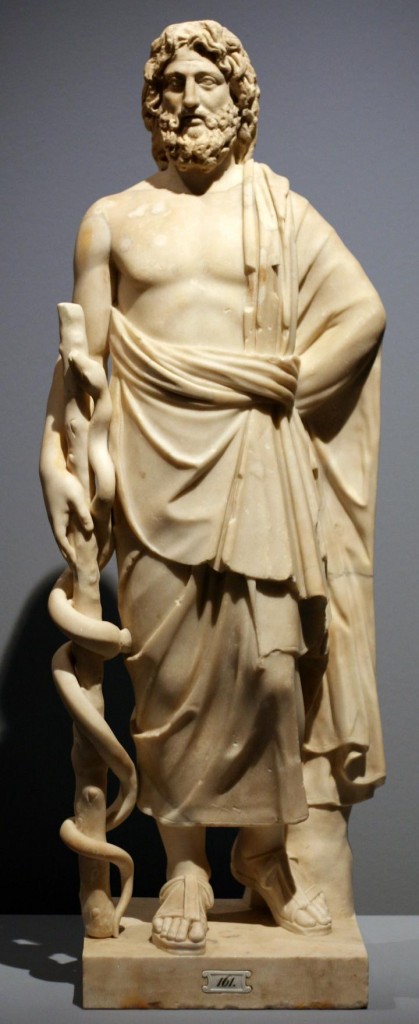
The same island where one of Hiram’s First Masons: The Cunning Daedalus Invented the Masonic Working Tools. 33rd Degree Freemason, Albert Gallatin Mackey had said Daedalus executed the Cretan labyrinth, the reservoir near Megaris in Sicily, the Temple of Apollo at Capua, and the celebrated altar sculptured with lions on the Libyan coast.
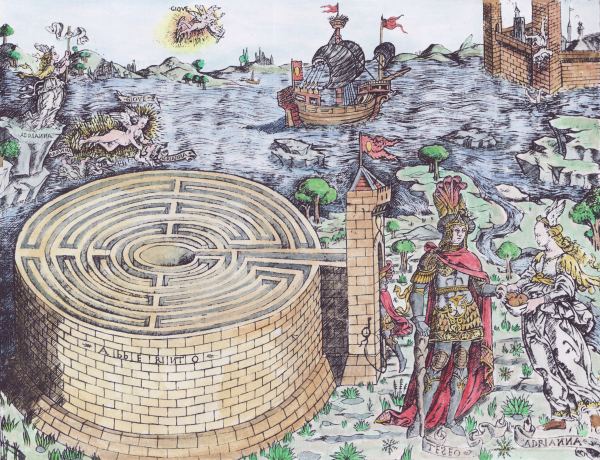
Mackay also said he was the inventor of a number of the “Working Tools” used in the various degrees of Masonry such as the compasses and square, the plumb-line and the axe, most of the tools used in carpentry, and of glue and his nephew, Perdix, is the reputed inventor of the third Great Light in Masonry, the Compasses, which are dedicated to the Craft. (page 945)
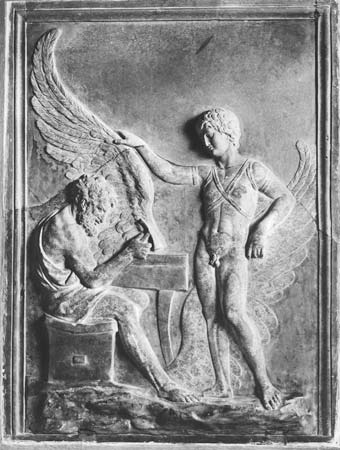
As I have explained on numerous occasions, the Freemasons are the inheritors of the world’s Gnostic mysteries with their most prized symbols – the letter G signifying Gnosis, the Blazing Star (Pentagram), and Compasses and Square.
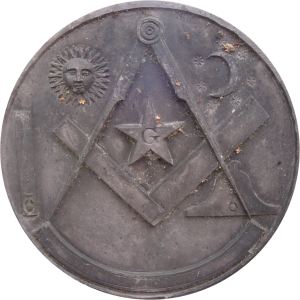
It is said in the Scripture of the Great Fall of the Masonic King Hiram of Tyre in Ezekiel 28:12-19;
“Mortal, raise a lamentation over the king of Tyre, and say to him, Thus says the Lord GOD: You were the signet of perfection, full of wisdom and perfect in beauty. You were in Eden, the garden of God; every precious stone was your covering, carnelian, chrysolite, and moonstone, beryl, onyx, and jasper, sapphire, turquoise, and emerald; and worked in gold were your settings and your engravings. On the day that you were created, they were prepared.
With an anointed cherub as guardian, I placed you; you were on the holy mountain of God; you walked among the stones of fire. You were blameless in your ways from the day that you were created, until iniquity was found in you. In the abundance of your trade, you were filled with violence, and you sinned; so I cast you as a profane thing from the mountain of God (Holy Mountain), and the guardian cherub (Satan) drove you out from among the stones of fire.
Your heart was proud because of your beauty; you corrupted your wisdom for the sake of your splendor. I cast you to the ground; I exposed you before kings, to feast their eyes on you. By the multitude of your iniquities, in the unrighteousness of your trade, you profaned your sanctuaries. So I brought out fire from within you; it consumed you, and I turned you to ashes on the earth in the sight of all who saw you. All who know you among the peoples are appalled at you; you have come to a dreadful end and shall be no more forever.”
As I said before, Simon Magus, a man we know as the First Gnostic and also Satan was also called the “anointed cherub” and made a guardian of the Holy of Holies. We learn from Saint Irenaeus that Simon’s consort Helen is a converted slave and prostitute from the Phoenician city of Tyre.
Helen was considered the Lost Sheep with no Gnosis of her royal soul, forced to wander through the centuries from vessel to vessel (including that of Helen of Troy), until she ended up at the brothel in Tyre where Simon had discovered her.
The same Holy Island of Crete where Hiram is the Widow’s Son and his Sovereign Masons are world-renown.
Knowing she was the One, he purchased her from her master and she became his Gnostic disciple (student) during his travels and teachings.
it was said that their reunion (Union of Soul/Opposites/Duality Become One) represented the beginning of the redemption of the world, and was the model for the process of salvation ie: Gnosis to Simon’s followers – the True Gnostics being that of the exoteric Catholic Church and esoteric Freemasons.
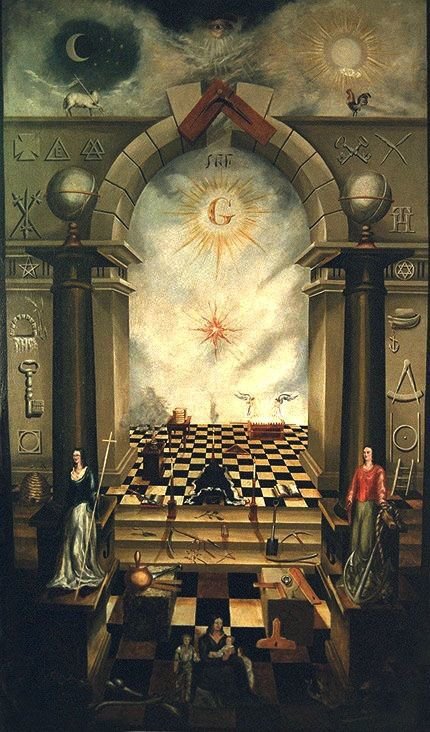
Moe is the founder of GnosticWarrior.com. He is a father, husband, author, martial arts black belt, and an expert in Gnosticism, the occult, and esotericism.





















